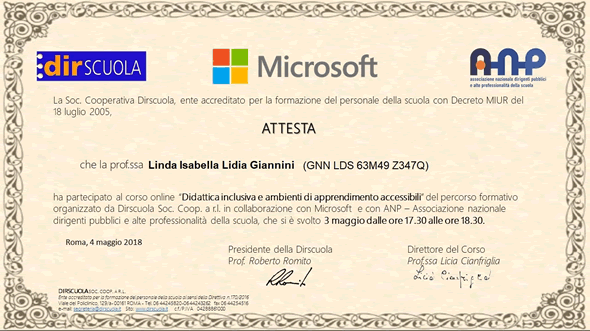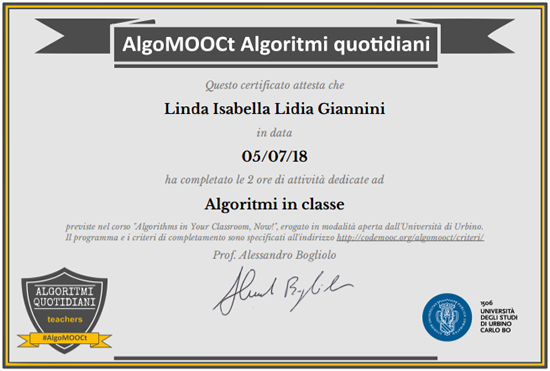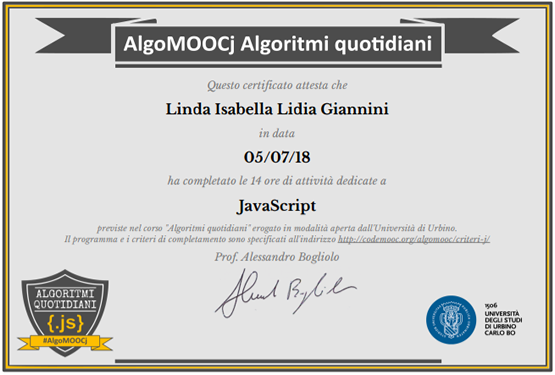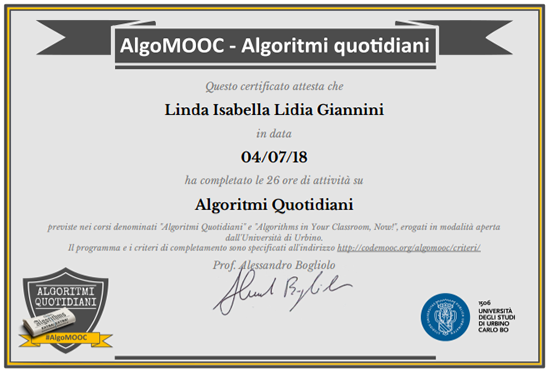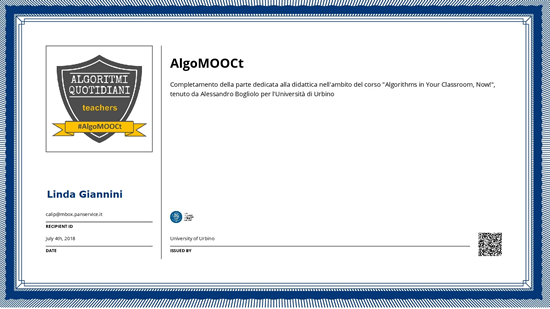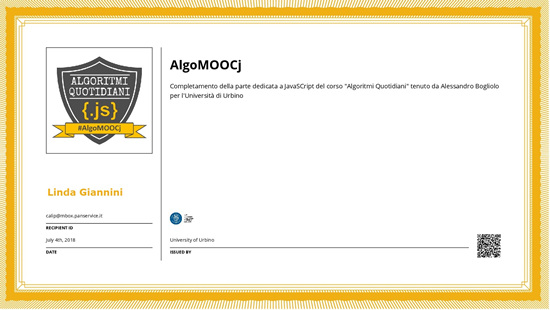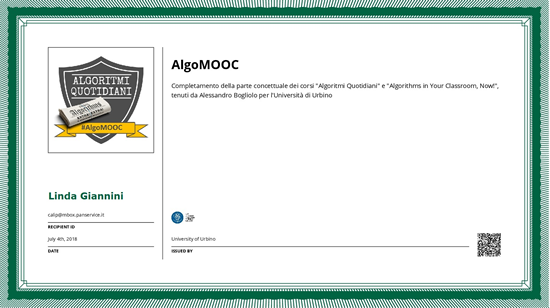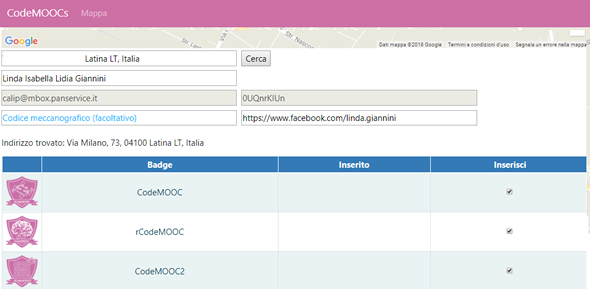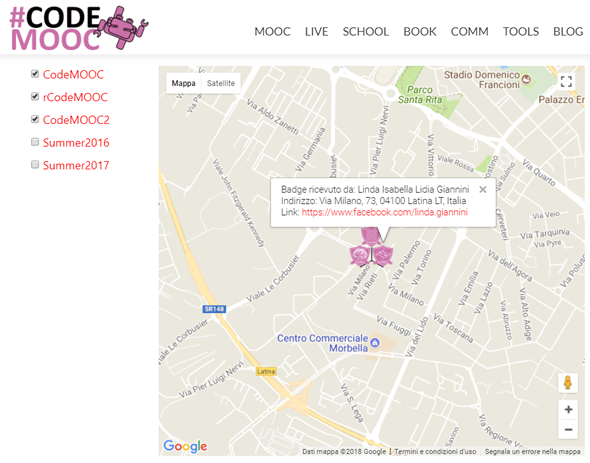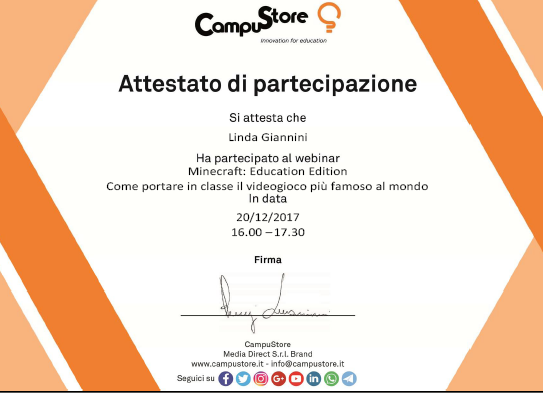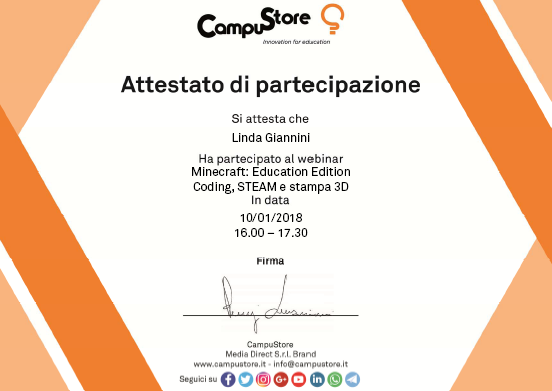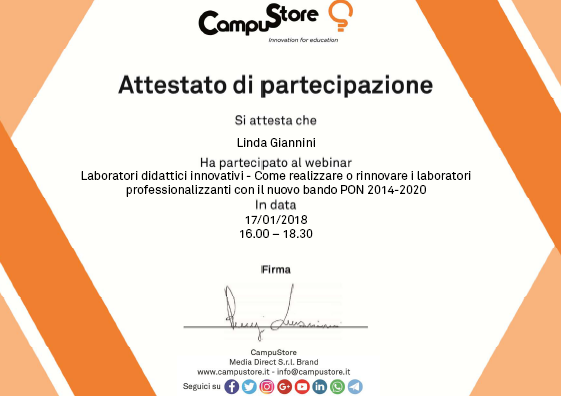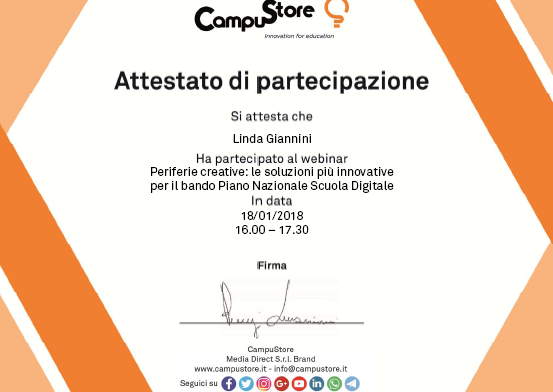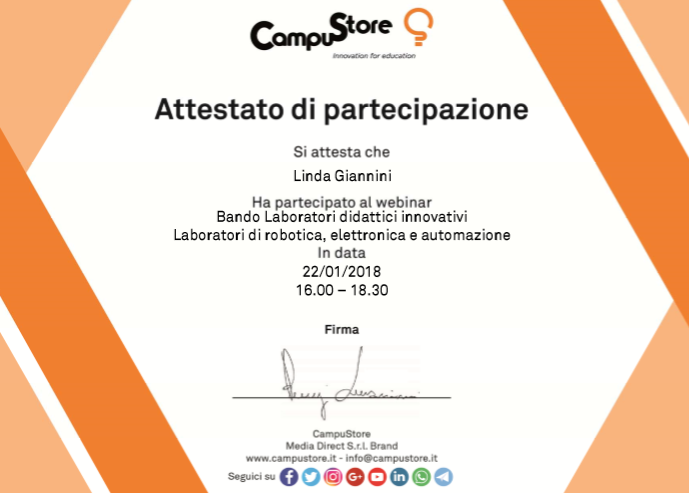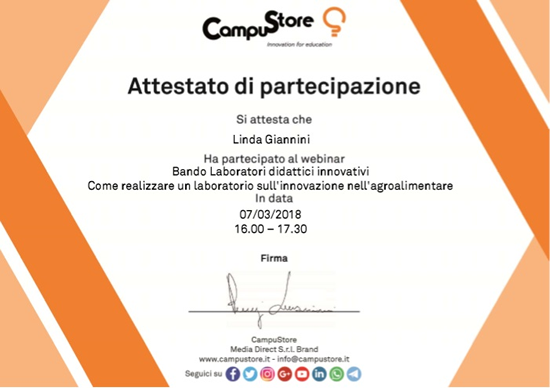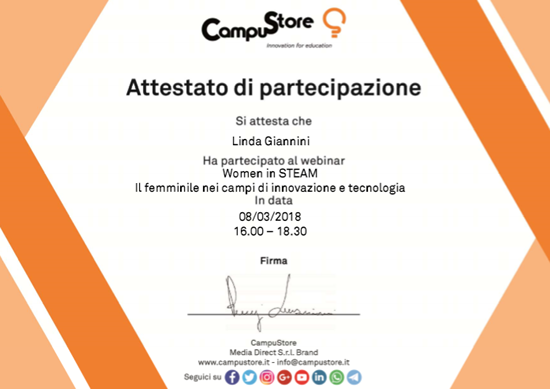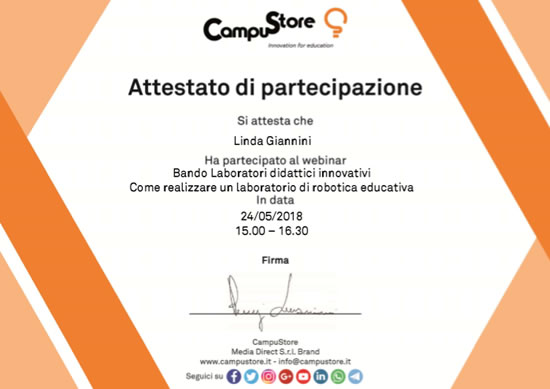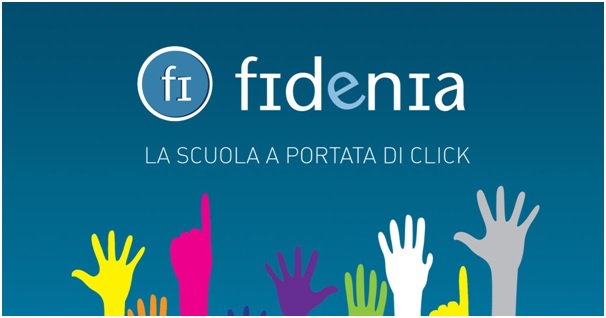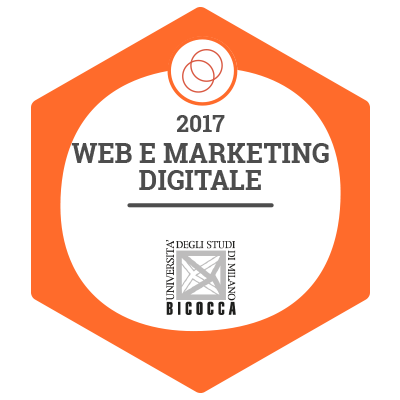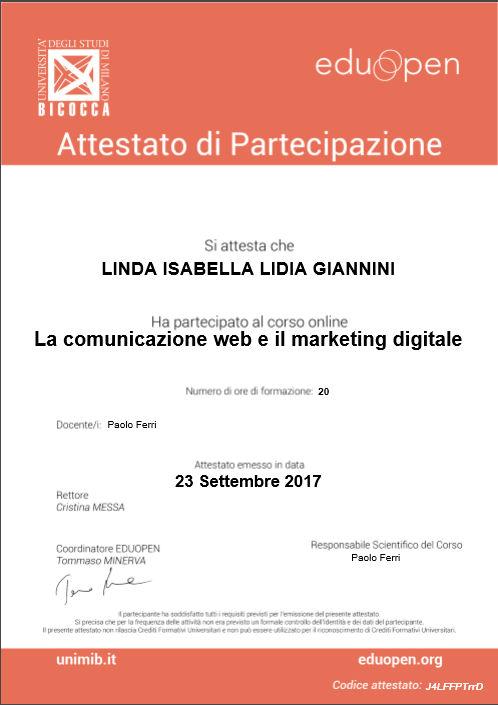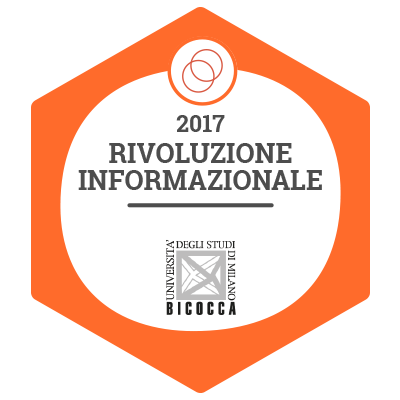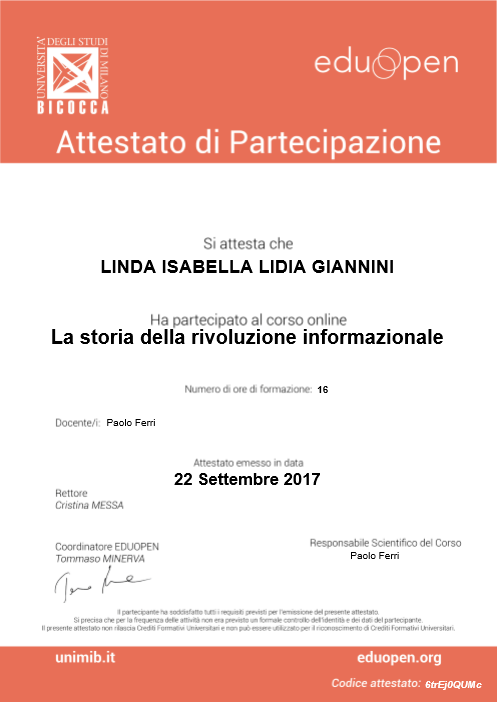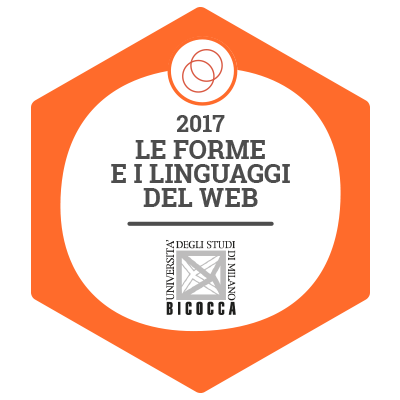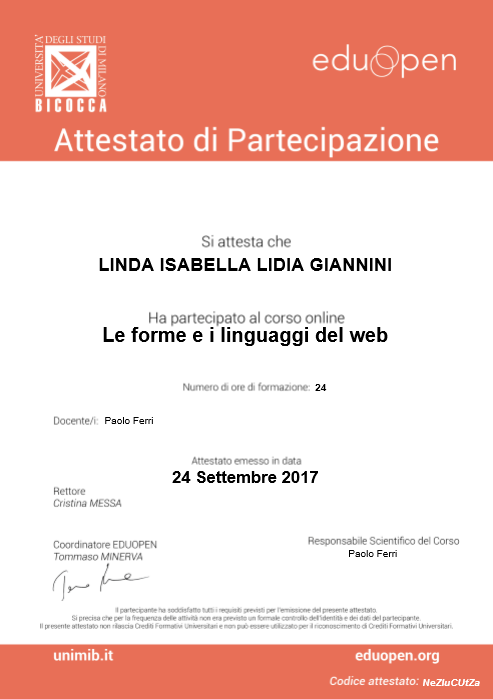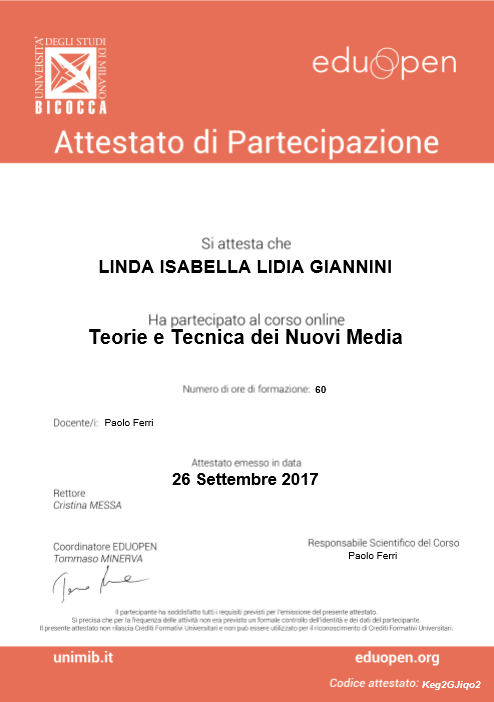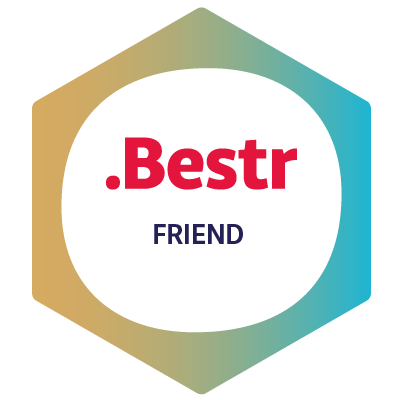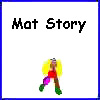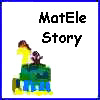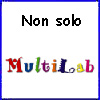|
Aggiornamento
2017/2018
|
| 
|
| |
| |
| |
| |
| |
| |
| |
| |
| |
| |
| |
| |
| |
| |
| |
| |
| |
 |
LE
RISORSE
http://codemooc.org/le-risorse-tmp/ |
|
| |
| |
| |
| |
| |
| |
| |
| |
| |
| |
| |
| |
| |
| |
| |
| |
| |
| |
| |
| |
| |
| |
| |
| |
| |
| |
| |

Learning
Creative Learning [MIT]
http://learn.media.mit.edu/lcl-archive-2014/
Community
of educators, designers, parents, and tinkerers exploring new
ways to support creating, experimenting, and learning. Together
we can reimagine and reinvent education. |
|
| |
| |
| |
| |
| |

Collaborative
Teaching and Learning - 2nd edition
 https://www.facebook.com/groups/COLABEU/ https://www.facebook.com/groups/COLABEU/

 https://twitter.com/hashtag/colab_eu https://twitter.com/hashtag/colab_eu

 COLAB-MOOC-SYLLABUS COLAB-MOOC-SYLLABUS
 Collaborative
Teaching and Learning - 2nd edition Collaborative
Teaching and Learning - 2nd edition 
 https://www.youtube.com/watch?v=vNdIsbl2Q6Y
https://www.youtube.com/watch?v=vNdIsbl2Q6Y

Learning-Diaries:
Il padlet del percorso formativo
https://padlet.com/LindaGiannini/co_lab
[padlet
in PDF]
Scenario
http://www.descrittiva.it/calip/1718/CoLabLearnigScenario.pdf

SUTORI Create and share visual stories.
Together
https://www.sutori.com/
login https://www.sutori.com/login
Playing and learning together, by Linda Giannini
https://www.sutori.com/story/playing-and-learning-together
 Login Login

My
last work - Learning
Designer https://v.gd/PldaiG
1. Hand in your task > 2. Review
your colleagues > 3. Reviews received
Review made By Anna Maria Mulliri date 25-10-2017 21:08
Review of Lia Molini + Bojana by Linda
Giannini
Pannello
dei badges
http://www.europeanschoolnetacademy.eu/web/guest/my-page1
badge
[01]- [02]
- [03] -[04]
- [finale]

Course
history
- Course
Introduction 100% done
- Module
1: What is collaborative learning?
100% done
- Module
2: How can you design collaborative learning in the classroom?100%
done
- Module
3: How can you assess collaborative learning?100% done
- Module
4: How can teacher collaboration facilitate collaborative
learning?
100% done
|

Collaborative
Teaching and Learning - 2nd edition
On the Collaborative Teaching
and Learning course, you will receive advice from experts
and peers, as well as concrete suggestions about how to carry
out collaborative teaching and learning in your classroom.
You will also have access to videos of inspiring practice
and other support material. Moreover, you will have the chance
to belong to a Europe-wide community of like-minded practitioners,
dedicated to working together to make collaborative teaching
and learning a reality in the classroom.Module 1: What is
collaborative learning?
Module
1: What is collaborative learning?
How do I get it?This badge is awarded upon
successful completion of Module 1 on the Collaborative Teaching
and Learning (2nd edition) course at the European Schoolnet
Academy. Description: The course participant
who has successfully passed this module has achieved the following
learning outcomes: 1. Understanding the full meaning of collaborative
learning, and that it requires more than simply putting students
in groups; 2. Appreciating the key benefits collaborative
learning can bring to students and the specific skills it
helps develop; 3. Appreciating how collaborative learning
can be facilitated by a flexible, interactive classroom, and
also through project-based learning; 4. Creating a personal
Learning Diary to log learning activities, reflections and
resources from the course; 5. Reflecting in their Learning
Diary on two learning activities and whether they require
a low or high level of collaboration from students.
Module
2: How can you design collaborative learning in the classroom?
How do I get it? This badge
is awarded upon successful completion of Module 2 on the Collaborative
Teaching and Learning (2nd edition) course at the European
Schoolnet Academy. Description: The course
participant who has successfully passed this module has achieved
the following learning outcomes: 1. Understanding how to embed
collaborative learning into lesson design; 2. Appreciating
the four dimensions of collaborative learning concerning group
work, shared responsibility, making substantive decisions,
and interdependent work; 3. Understanding how the 21st Century
Learning Design Collaboration Rubric and Learning Scenarios
can help them reflect and design collaborative learning activities;
4. Assessing the two collaborative learning activities they
described in Module 1, using the 21 CLD Rubric, and reporting
in their Learning Diary.
Module
3: How can you assess collaborative learning?
How do I get it? This badge is awarded upon
successful completion of Module 3 on the Collaborative Teaching
and Learning (2nd edition) course at the European Schoolnet
Academy. Description: The course participant
who has successfully passed this module has achieved the following
learning outcomes: 1. Understanding the principles of assessing
collaborative learning; 2. Appreciating the various challenges
teachers face in assessing collaborative learning and the
tips, tools and solutions available to them; 3. Understanding
the value of using rubrics and checklists for assessing collaborative
learning, and how to construct them; 4. Appreciating the importance
of involving students in the definition of assessment tools
used for collaborative learning; 5. Beginning work on one
or more lesson plans integrating collaborative learning and
assessment using the Learning Designer.
Module
4: How can teacher collaboration facilitate collaborative
learning?
How do I get it? This badge is awarded upon
successful completion of Module 4 on the Collaborative Teaching
and Learning (2nd edition) course at the European Schoolnet
Academy. Description: The course participant
who has successfully passed this module has achieved the following
learning outcomes: 1. Appreciating the benefits of teacher
collaboration and how best to take advantage of them, as well
as the challenges involved, and tips and tools for overcoming
them; 2. Understanding the skills needed by teachers for effective
collaboration, as well as the conditions needed at the school
level for teacher collaboration to flourish; 3. Understanding
how technology can facilitate teacher collaboration; 4. Using
the Learning Designer to finalise the development of one or
more lesson plans integrating collaborative learning and assessment,
along with elements of teacher collaboration; 5. Peer-reviewing
the collaborative lesson plans of two other course participants.
Collaborative Teaching
and Learning (2nd Edition) Course Badge
How do I get it? This
badge is awarded upon successful completion of the Collaborative
Teaching and Learning (2nd Edition) course at the European Schoolnet
Academy. Description: The course participant
who receives this badge has achieved the following learning
outcomes: 1. Understanding what collaborative learning is; 2.
Learning how to carry it out effectively in my classroom; 3.
Figuring out what tools they can use to assess collaborative
learning; 4. Learning how they can collaborate with fellow teachers
to facilitate collaborative learning.
|
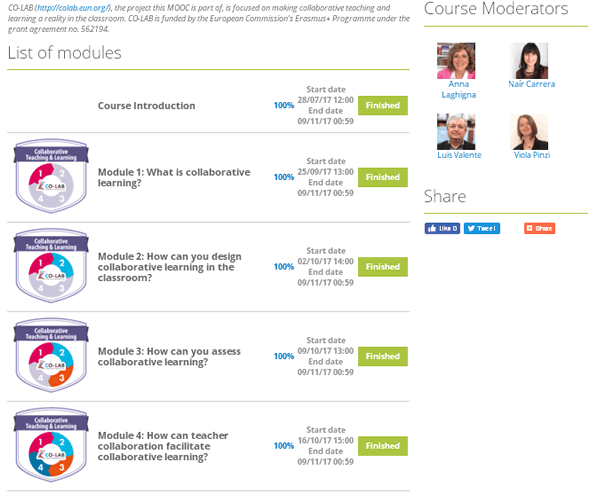
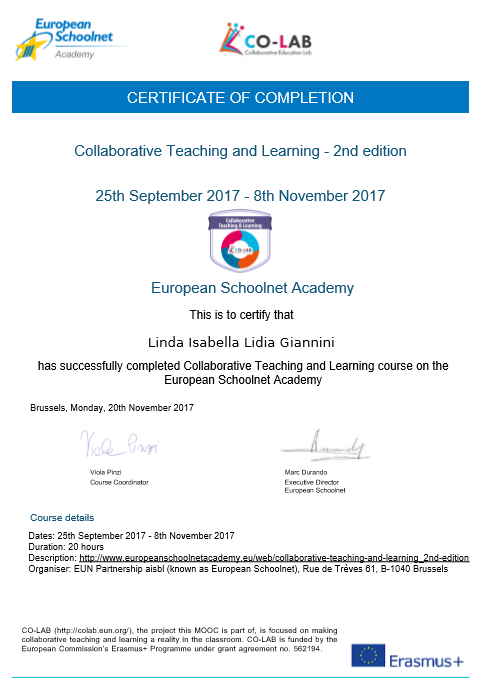
[il
certificato]
|
| |

Opening
Schools to STEM Careers
ttp://www.europeanschoolnetacademy.eu/web/opening-schools-to-stem-careers
 Opening
Schools to STEM Careers
Opening
Schools to STEM Careers 
 https://www.facebook.com/groups/STEMcareersMOOC/
https://www.facebook.com/groups/STEMcareersMOOC/

 #STEMcareersMOOC #STEMcareersMOOC

 https://www.youtube.com/watch?v=o4mUYNNZpEw
https://www.youtube.com/watch?v=o4mUYNNZpEw

My
last work
Final activity
Linda Isabella Lidia Giannini
STEM Careers Learning Diary - European
Schoolnet Academy
https://plus.google.com/communities/105677005483295112045
[my
work]
Learning-Diaries:
Il padlet del percorso formativo
https://padlet.com/LindaGiannini/STEM_courseEU
[padlet
in PDF]
Valutazione
del mio Learning Designer
Review made By Renata Restivo date 13-11-2017
17:32
I really like your work. It is complete and clear.
I agree with you about your answers. Bye Reanata
Review made By Gabriella Canciani date
13-11-2017 23:07
I appreciate your evaluation of your situation and
I hope you will think about any possible way to improve STEM
perception in your school, good luck
My
review to
Review of Marija Dikic
Review of Renata Restivo
Review of Francesca Fallacara

Peer-review checklist is done by Irina Adamovich to Marija Dikic
Mooc2-STEM-careers-final-activity-School-Plan-FINAL
Pannello
dei badges
http://www.europeanschoolnetacademy.eu/web/guest/my-page1
badge
[01]- [02]
- [03] -[04]
- [05] - [06]
- [07] - [finale]
Course
history
- Course
Introduction 100% done
- Module
1: STEM careers in schools and in the job market 100% done
- Module
2: STEM career pathways 100% done
- Module
3: STEM leading schools 100% done
- Module
4: Gender stereotypes in STEM education 100% done
- Module
5: Balancing the roles of teachers, mentors, parents and role
models 100% done
- Module
6: Benefits of external school to work programs 100% done
- Module
7: Career orientation events on STEM education 100% done
|

Opening
Schools to STEM Careers
The Opening Schools to STEM Careers MOOC is meant to train
and empower Heads of Schools and Career Counsellors in successfully
equipping -and adapting- schools with tools for introducing
and attracting young people to STEM careers. During this course,
participants will learn how to recognize relevant STEM career
pathways, identify significant STEM skills and soft abilities,
address gender stereotypes, collaborate at in-school-level
for STEM career counselling and host and create STEM career
events and overall, among others.
Module 1: STEM careers
in schools and in the job market
How do I get it?This
badge is awarded upon successful completion of Module 1 on
the Opening Schools to STEM Careers course at the European
Schoolnet Academy. Description: The course
participant who has successfully passed this module has achieved
the following learning outcomes: 1. Learning what we mean
by STEM and why STEM studies are important; 2. Understanding
what the STEM skill gap is while having a critical approach
to it; 3. Assimilating the main benefits of career counselling
in schools and understanding different cognitive-behaviour
dimensions as pillars of career development; 4. Getting an
introduction to school strategies to foster STEM career awareness,
taking into account different possible types of school career
counselling scenario
Module
2: STEM Careers pathways
How do I get it? This
badge is awarded upon successful completion of Module 2 on
the Opening Schools to STEM Careers course at the European
Schoolnet Academy. Description: The course
participant who has successfully passed this module has achieved
the following learning outcomes: 1. Learning about current
STEM industries and professions; 2. Understanding the evolution
of STEM professions and jobs of the future; 3. Defining and
recognising what STEM skills are -- specifically, learning
about the importance of introducing ICT and digital skills
in schools; 4. Comprehending what soft skills are and how
these can be transferred to students.
Module
3: STEM leading schools
How do I get it? This
badge is awarded upon successful completion of Module 3 on
the Opening Schools to STEM Careers course at the European
Schoolnet Academy. Description: The course
participant who has successfully passed this module has achieved
the following learning outcomes: 1. Comprehending the concept
of school leadership and its typologies and the concept of
a STEM leading school; 2. Understanding the different types
of career-counselling approaches at the school level; 3. Learning
how to integrate different professional roles into STEM career
awareness; 4. Learning how to build a STEM career-counselling
vision and action plan for their school.
Module
4: Gender stereotypes in STEM education
How do I get it? This
badge is awarded upon successful completion of Module 4 on
the Opening Schools to STEM Careers course at the European
Schoolnet Academy. Description: The course
participant who has successfully passed this module has achieved
the following learning outcomes: 1. Understanding the concept
of the STEM gender gap and learning how to analyse data regarding
the situation of girls and women in STEM careers; 2. Learning
strategies to further address gender equality in schools and
to propel girls into STEM careers; 3. Learning about female
scientists (present and past) and about current initiatives
promoting girls in STEM.
Module
5: Balancing the roles of teachers, mentors, parents and role
models
How do I get it? This
badge is awarded upon successful completion of Module 5 on
the Opening Schools to STEM Careers course at the European
Schoolnet Academy. Description: The course
participant who has successfully passed this module has achieved
the following learning outcomes: 1. Developing the concept
of mentorship and learning how it can be integrated in schools
(with a focus on the roles of career counsellors and heads
of schools); 2. Learning how to manage the role of parents
in career awareness activities; 3. Learning how to integrate
STEM professionals in school activities.
Module
6: Benefits of external school to work programs
How do I get it? This
badge is awarded upon successful completion of Module 6 on
the Opening Schools to STEM Careers course at the European
Schoolnet Academy. Description: The course
participant who has successfully passed this module has achieved
the following learning outcomes: 1. Learning about the types
of school-to-work programmes available and where to find them;
2. Learning how to guide students towards school-to-work programmes.
Module
7: Career orientation events on STEM education
How do I get it? This
badge is awarded upon successful completion of Module 7 on
the Opening Schools to STEM Careers course at the European
Schoolnet Academy. Description:
The course participant who has successfully passed
this module has achieved the following learning outcomes:
1. Becoming aware of the main benefits of organising STEM
career events in schools; 2. Learning tips and steps for organising
their own STEM career event in their school; 3. Exploring
case studies of various STEM career events.
Opening
Schools to STEM Careers Course Badge
How do I get it? This
badge is awarded upon successful completion of the Opening
Schools to STEM Careers course at the European Schoolnet Academy.
Description: The course participant who receives
this badge has achieved the following learning outcomes: 1.
Understanding why STEM is critical for students’ future welfare
and success; 2. Recognising some of the most relevant STEM
career pathways; 3. Appreciating different types of career
counselling approaches at the school level; 4. Determining
the most significant soft skills and STEM abilities, methodologies
and pedagogical approaches that teachers and career counsellors
should use/focus on; 5. Learning how to address gender stereotypes
and foster a culture of understanding; 6. Learning how to
collaborate within the school on the subject of STEM career
counselling (including collaboration between parents and teachers);
7. Learning how to initiate and maintain community partnerships
for STEM career counselling; 8. Learning how to host and create
STEM career events; 9. Learning how to build a STEM career
counselling vision and an action plan for schools (including
leadership perspective aspects).
|
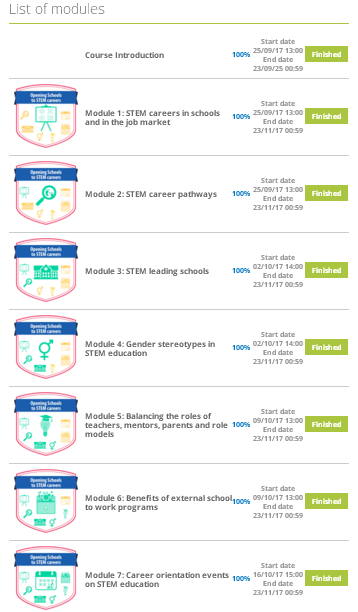
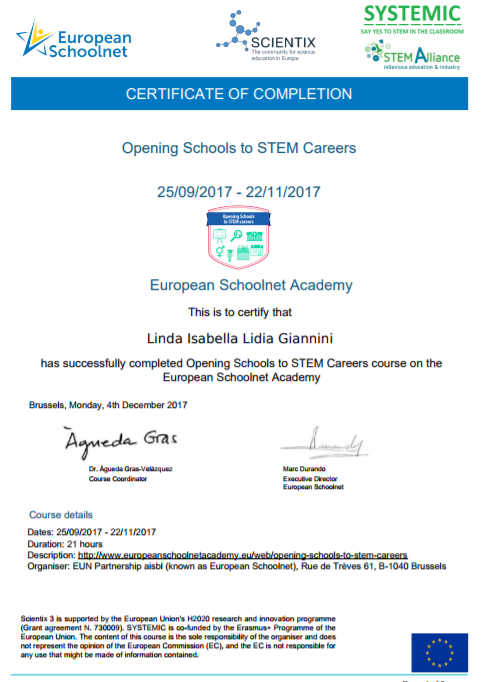
[il
certificato]
|
| |

Our
Fragile Planet
http://www.europeanschoolnetacademy.eu/web/our-fragile-planet
 https://www.facebook.com/groups/spaceawarenessmoocs/
https://www.facebook.com/groups/spaceawarenessmoocs/

 #spaceMOOC #spaceMOOC

 https://www.youtube.com/watch?v=FjLrBB7gXzM
https://www.youtube.com/watch?v=FjLrBB7gXzM

My
last work: Learning Designer
https://v.gd/FmM6mU
Learning-Diaries:
Il padlet del percorso formativo
IL MIO PADLET FINALE:
Learnind Diary
https://padlet.com/LindaGiannini/Our_Fragile_Planet_myLearningDiary
[padlet
in PDF]
Valutazione
del mio Learning Designer
Review
made By Stella Spanou date 06-11-2017 18:50
Review made By anna zanotti date 07-11-2017 16:14
Review made By jeane de fatima fatima date 07-11-2017 13:45
My
review to
Review of Cira Serio
Review of Sonja Jankulovska
Review of Giuseppe Emanuele Verga
Pannello
dei badges
http://www.europeanschoolnetacademy.eu/web/guest/my-page1
badge
[01]- [02]
- [03] - [04]
- [finale]
Course
history

Our
Fragile Planet
The basic idea of the current MOOC “Our Fragile Planet” is
to empower teachers from all levels of educations to teach
space- and astronomy-related topics to their students, as
it was done in the previous three MOOCs. This online course
is built in such a way so that all teachers can participate,
focusing especially on those who are interested in astronomy
but never had the opportunity to learn more about it or have
very little background information and do not feel comfortable
to communicate basic information about our planet to their
students.
Badge Our Fragile
Planet course badge
How do I get it? The
recipient of this badge has completed successfully all modules
of the Our Fragile Planet course on the European Schoolnet
Academy. The recipient has passed all quizzes on the topics
of the modules, written a lesson plan incorporating ideas
from the course, engaged with peers in discussion about the
module questions as well as reviewed the work of 3 other course
participants. Description: This MOOC explored
the properties of planet Earth, Earth’s movements and seasons,
ICT tools could be used to teach about its properties and
various gender balance in the classroom tips for teachers.
The course then explored how to become familiarized with Earth’s
climate and weather, raised awareness of climate change and
global warming, the importance of natural resources and the
related ICT tools to teach about these topics. This information
was supplemented with classroom videos and teacher interviews
based on Space Awareness teaching activities. The MOOC was
built in such a way that all teachers that participated had
the opportunity to learn more about these notions and feel
comfortable to communicate basic information about planet
Earth to their students.
|
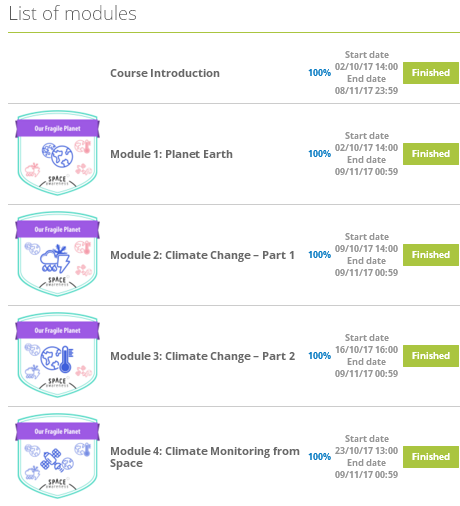
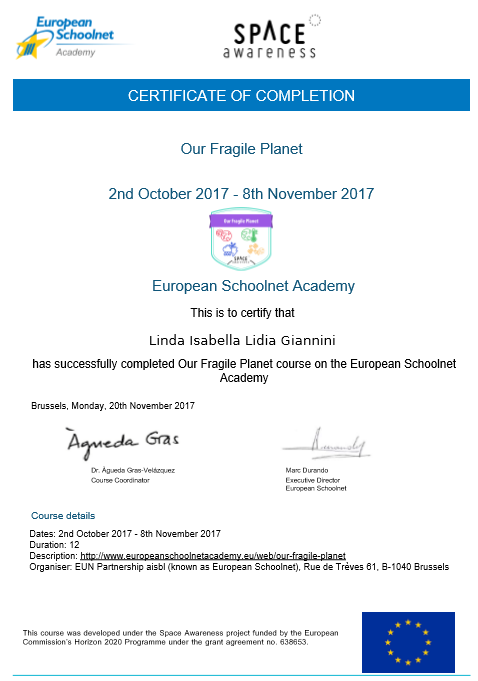
[il
certificato]
|
| |

Progressing
Technology-Enhanced Teaching - MENTEP
[home
corso]
 https://www.facebook.com/groups/progressing.technology.enhanced.teaching/
https://www.facebook.com/groups/progressing.technology.enhanced.teaching/

 https://www.youtube.com/watch?v=NkgyRijfrHk
https://www.youtube.com/watch?v=NkgyRijfrHk

 #MENTEPcourse #MENTEPcourse

 MENTEP-EUN-Academy MENTEP-EUN-Academy

Learning-Diaries:
Il padlet del percorso formativo
IL MIO PADLET FINALE:
Learnind Diary
https://padlet.com/LindaGiannini/MENTEP
Pannello
dei badges
http://www.europeanschoolnetacademy.eu/web/guest/my-page1
 My
Competence Evidence 01 My
Competence Evidence 01 
 My
Competence Evidence 02
My
Competence Evidence 02

> 1. Hand in your task <
> 2. Review your colleagues <
The time for handing in ends on 14-12-2017 00:59:00
You had correct 2 of 2 activities
Review of Maria Luisa Borriello
Review of Vittoria D'Aquila
> 3. Reviews received
<
Review made By Eva Capuano date 30-11-2017 15:44



badge
[01]- [02]
- [03] - [finale]
- Course
Introduction 100% done
- Module
1: Identifying competency examples for the TET-SAT tool 0%
done
- Module
2: Developing your self-assessment in TET-SAT 0% done
- Module
3: Peer review to develop TET-SAT 0% done
|

Course
history
| Progressing
Technology-Enhanced Teaching - MENTEP
The MENTEP project developed a new online tool for teachers
to self-assess their digital competence in teaching. During
this MOOC, course participants will have the opportunity to
use this new tool. The tool provides participants with feedback
and resources that help them to improve their own digital competence
in teaching. Moreover, course participants will be invited to
describe examples from their own teaching to illustrate the
5 different levels (from beginner to expert) of the tool. After
the course, a selection of these examples will be linked directly
to the tool, making it even more relevant for teachers.
Module
1: Identifying competency examples for the TET-SAT tool
How do I get it? This badge is awarded upon
successful completion of Module 1 on the Progressing Technology-Enhanced
Teaching (Public) course at the European Schoolnet Academy.
Description: The course participant who has
successfully passed this module has achieved the following learning
outcomes: 1. Developing an understanding of the TET-SAT tool;
2. Being able to apply the TET-SAT tool to their own professional
context; 3. Being able to relate examples to the descriptors/levels
in the TET-SAT tool.
Module
2: Developing your self-assessment in TET-SAT
How do I get it? This badge is awarded upon
successful completion of Module 2 on the Progressing Technology-Enhanced
Teaching (Public) course at the European Schoolnet Academy.
Description: The course participant who has
successfully passed this module has achieved the following learning
outcomes:
Module
3: Peer-review to develop TET-SAT
How do I get it? This
badge is awarded upon successful completion of Module 3 on the
Progressing Technology-Enhanced Teaching (Public) course at
the European Schoolnet Academy. Description:
The course participant who has successfully passed
this module has achieved the following learning outcomes: |
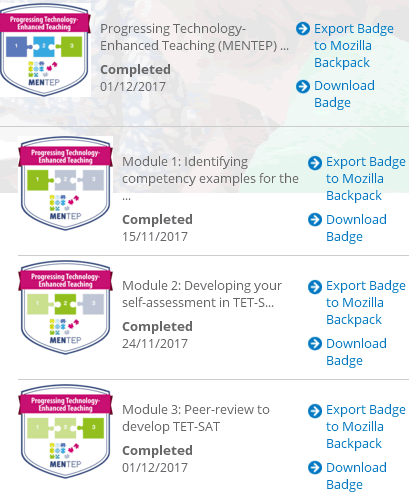
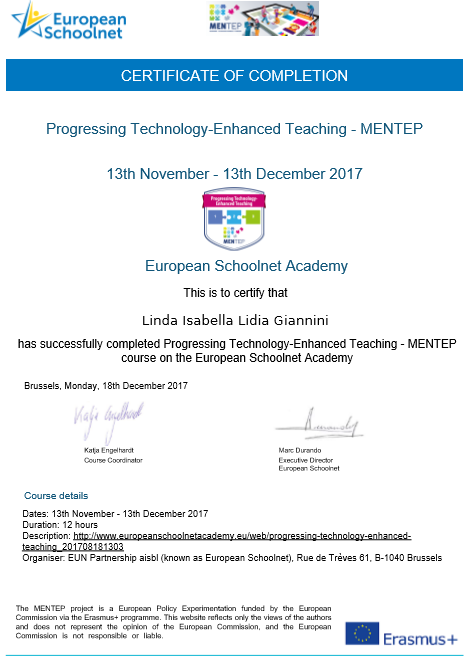
[il
certificato]
|
| |

Online
Safety (new and updated edition)
6th February 2018 -> 06/03/18
 Online
Safety Facebook group Online
Safety Facebook group
 Twitter
using #OnlineSafetyMOOC Twitter
using #OnlineSafetyMOOC
 Online
Safety - MOOC Intro Online
Safety - MOOC Intro
il
mio padlet
https://padlet.com/LindaGiannini/Onlinesafety
Pannello
dei badges
http://www.europeanschoolnetacademy.eu/web/guest/my-page1


Course
history
| Online
Safety (new and updated edition)
The Online Safety MOOC aims to empower primary and secondary
teachers and give them a better understanding of the opportunities,
risks and challenges presented to children and young people,
and their parents and teachers, in the online world of the 21st
century. Teachers will learn about a variety of topics such
as media literacy, cyber bullying, online relationships, sexting,
online hate speech and radicalisation, and will be provided
with high-quality resources to address these issues.

[01]
- [02] - [03]
- [04] - [05]
Module 1: An Introduction to Online
Safety
The course participant who has successfully passed
this module has achieved the following learning objectives:
1. Learning the main risks faced by children and young people
when they go online; 2. Discovering how schools can support
pupils and their parents; 3. Understanding what teachers need
to take into consideration with regard to managing their own
online reputation; 4. Finding out if there is a statutory requirement
to teach/deliver online safety in schools.
Module
1 Badge
How do I get it? This
badge is awarded after successfully completing Module 1 of the
Online Safety course. Description
The course participant who has successfully passed
this module has achieved the following learning objectives:
1. Learning the main risks faced by children and young people
when they go online; 2. Discovering how schools can support
pupils and their parents; 3. Understanding what teachers need
to take into consideration with regard to managing their own
online reputation; 4. Finding out if there is a statutory requirement
to teach/deliver online safety in schools.
Module 2: Media Literacy and Fake News
The
course participant who has successfully passed this module has
achieved the following learning objectives: 1. Considering the
various dimensions of media literacy; 2. Understanding why media
literacy and its different dimensions are important for children
and young people; 3. Understanding how media literacy links
to some topical issues such as fake news, data privacy, and
copyright; 4. Coming up with ideas on how to develop media literacy
with your students.
Module
2 Badge
How do I get it? This
badge is awarded after successfully completing Module 2 of the
Online Safety course. Description The course
participant who has successfully passed this module has achieved
the following learning objectives: 1. Considering the various
dimensions of media literacy; 2. Understanding why media literacy
and its different dimensions are important for children and
young people; 3. Understanding how media literacy links to some
topical issues such as fake news, data privacy, and copyright;
4. Developing ideas on how to develop media literacy with your
students.
Module 3 Badge
The
course participant who has successfully passed this module has
achieved the following learning objectives: 1. Hearing from
anti-bullying ambassadors and online safety experts; 2. Learning
more about the European Network Against Bullying in Learning
and Leisure Environments (ENABLE); 3. Understanding how to develop
social and emotional learning skills; 4. Discovering how to
set up an effective peer-support scheme; 5. Discussing their
own role with others; 6. Thinking about their own well-being
and that of others online.
Module
3 Badge
How do I get it? This
badge is awarded after successfully completing Module 3 of the
Online Safety course. Description The course
participant who has successfully passed this module has achieved
the following learning objectives: 1. Hearing from anti-bullying
ambassadors and online safety experts; 2. Learning more about
the European Network Against Bullying in Learning and Leisure
Environments (ENABLE); 3. Understanding how to develop social
and emotional learning skills; 4. Discovering how to set up
an effective peer-support scheme; 5. Discuss their own role
with others; 6. Think about their own well-being and that of
others online.
Module
4 of the Online Safety course
The
course participant who has successfully passed this module has
achieved the following learning objectives: 1. Gaining a better
understanding of what it’s like to grow up in this digital age/environment
and considering the pressures facing young people; 2. Exploring
the impact that technology can have on relationships; 3. Raising
awareness of the challenges associated with sexting, something
most schools have to deal with, and trying to understand why
young people engage in this risky practice and what can be done
to support them (and also their families); 4. Sharing information
about some of the resources that can be used to educate pupils
and parents about sexting and associated issues such as sextortion.
Module
4 Badge
How do I get it? This
badge is awarded after successfully completing Module 4 of the
Online Safety course. Description The course
participant who has successfully passed this module has achieved
the following learning objectives: 1. Looking at what it’s like
to grow up in this digital age/environment and considering the
pressures facing young people; 2. Looking specifically at sexting,
something which most schools have to deal with, and trying to
understand why young people engage in this risky practice and
what can be done to support them (and also their families);
3. Looking at some of the resources we can use to educate pupils
and parents about sexting and associated issues such as sextortion.
Module
5: Hate Speech and Radicalisation
The course participant who has successfully passed
this module has achieved the following learning objectives:
1. Learning what online hate speech and radicalisation is; 2.
Hearing about educational approaches to promote critical thinking
and mutual respect; 3. Exploring some other strategies which
have emerged in the fight against online hate speech and radicalisation,
ranging from counterspeech to Community Standards on social
media platforms like Facebook, Twitter and YouTube, to the importance
of reporting harmful and possibly illegal content.
Module
5 Badge
How do I get it? This
badge is awarded after successfully completing Module 5 of the
Online Safety course. Description The course
participant who has successfully passed this module has achieved
the following learning objectives: 1. Learning what online hate
speech and radicalisation is. Where does it come from? Why do
we need to be concerned? Are there clear warning signs? And
what can we do about it?; 2. Hearing about educational approaches
to promote critical thinking and mutual respect – we will talk
about media literacy again, but also about digital citizenship
and social and emotional learning; 3. Exploring some other strategies
which have emerged in the fight against online hate speech and
radicalisation. These will range from counterspeech, over Community
Standards on social media platforms like Facebook, Twitter and
YouTube, to the importance of reporting harmful and possibly
illegal content.
|

|
| |

Inquiry-Based
Teaching in Life Sciences
Monday, 12th March 2018
 Inquiry-Based Teaching
in Life Sciences Facebook group Inquiry-Based Teaching
in Life Sciences Facebook group
 Twitter using Inquiry-Based
Teaching in Life Sciences Twitter using Inquiry-Based
Teaching in Life Sciences
 Inquiry-Based Teaching
in Life Sciences Inquiry-Based Teaching
in Life Sciences
il
mio padlet
https://padlet.com/LindaGiannini/TeachingSciences
Pannello
dei badges
http://www.europeanschoolnetacademy.eu/web/guest/my-page1

Course
history
| Inquiry-Based
Teaching in Life Sciences
The Inquiry-Based Teaching in Life Sciences MOOC is meant to
enhance life science teachers’ pedagogical competences and practices,
and improve their conceptual understanding of life science to
help them further establish and disseminate IBSE. The
MOOC will offer a selection of tested classroom activities and
resources from ten European countries to empower life science
teachers (12- to 19-year-old students) to introduce IBSE methodologies
in the classroom and help them reflect on their own practices.
In
this MOOC, participants will:
-
Experience
Inquiry as an adult learner
-
Acquire
the skills and confidence to implement Inquiry-Based Teaching
in the classroom
-
Learn
how to reflect on their own teaching practice
-
Enhance
their personal and their students’ conceptual understanding
of life sciences
-
Explore
various formal and informal assessment approaches for IBSE
|

[01] - [02] - [03]
- [04] - [05]
Inquiry-Based
Teaching in Life Sciences - Module 1: Experience inquiry as
a learner
How do I get it? This badge is awarded after
successfully completing Module 1 of the 'Inquiry-Based Teaching
in Life Sciences' course. Description The course
participant who has successfully passed this module has achieved
the following learning objectives: 1. Understanding the steps
& methodology of inquiry-based learning 2. Experiencing
inquiry in life sciences as an adult learner (by completing
one or more activities) 3. Identifying and reflecting on the
steps followed along their inquiry path 4. Comparing their own
practice with a given example
Inquiry-Based
Teaching in Life Sciences - Module 2: Implement inquiry in the
classroom
How do I get it? This badge is awarded after
successfully completing Module 2 of the 'Inquiry-Based Teaching
in Life Sciences' course. Description The course
participant who has successfully passed this module has achieved
the following learning objectives: 1. Building their skills
and confidence to implement IB teaching in the classroom 2.
Analysing at least one life science classroom implementation
(from a provided list) of IBSE 3. Accessing tips and good practices
from successful practitioners
Inquiry-Based Teaching in Life
Sciences - Module 3: Conceptual understanding of life sciences
How do I get it? This badge is awarded after
successfully completing Module 3 of the 'Inquiry-Based Teaching
in Life Sciences' course. Description The course
participant who has successfully passed this module has achieved
the following learning objectives: - Understanding the relevance
of new discoveries in other sciences that will be used in life
science - Understanding how ethics relates to the study of the
life sciences - Trying to implement activities referring to
the values and assumptions inherent to scientific knowledge
and the development of scientific knowledge.
Inquiry-Based Teaching in Life
Sciences - Module 4: Assessment and inquiry I
How do I get it? This badge is awarded after
successfully completing Module 4 of the 'Inquiry-Based Teaching
in Life Sciences' course. Description The course
participant who has successfully passed this module has achieved
the following learning objectives: - Became familiarized with
several assessment approaches for IBSE: rubrics, reports, digital
portfolios/learning diaries, writing to learn activities - Reflected
on their own assessment practice through the help of already
established educational practices of other teachers - Practiced
with and explored the various assessment methods presented
Online
Safety (new and updated edition) - Course Badge
How do I get it? The
recipient of this badge has successfully completed all modules
of the 'Online Safety' course on European Schoolnet Academy.
The recipient has passed all quizzes on the topics of the modules,
written a lesson plan incorporating ideas from the course, engaged
with peers in discussions about the module questions, and reviewed
the work of 3 other course participants. Description
The course explores online safety in a school context.
The objectives of the course are: 1. Understanding the challenges,
risks and benefits for young people using the internet and online
technologies; 2. Understanding the importance of maintaining
a positive online reputation and some strategies for managing
this effectively; 3. Raising awareness of, and signposting to
resources for teaching online safety in schools, as well as
raising awareness of the Better Internet for Kids strategy and
Insafe network, as part of the network of Safer Internet Centres
(SICs) in Europe, and associated resources. |

|
| |

Inquiry-Based
Teaching in Life Sciences
Monday, 12th March 2018
 Inquiry-Based Teaching
in Life Sciences Facebook group Inquiry-Based Teaching
in Life Sciences Facebook group
 Twitter using Inquiry-Based
Teaching in Life Sciences Twitter using Inquiry-Based
Teaching in Life Sciences
 Inquiry-Based Teaching
in Life Sciences Inquiry-Based Teaching
in Life Sciences
il
mio padlet
https://padlet.com/LindaGiannini/TeachingSciences
Pannello
dei badges
http://www.europeanschoolnetacademy.eu/web/guest/my-page1

Course
history
| Inquiry-Based
Teaching in Life Sciences
The Inquiry-Based Teaching in Life Sciences MOOC is meant to
enhance life science teachers’ pedagogical competences and practices,
and improve their conceptual understanding of life science to
help them further establish and disseminate IBSE. The
MOOC will offer a selection of tested classroom activities and
resources from ten European countries to empower life science
teachers (12- to 19-year-old students) to introduce IBSE methodologies
in the classroom and help them reflect on their own practices.
In
this MOOC, participants will:
-
Experience
Inquiry as an adult learner
-
Acquire
the skills and confidence to implement Inquiry-Based Teaching
in the classroom
-
Learn
how to reflect on their own teaching practice
-
Enhance
their personal and their students’ conceptual understanding
of life sciences
-
Explore
various formal and informal assessment approaches for IBSE
|
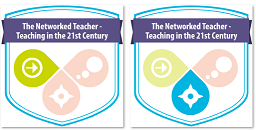
[01] - [02]
- [03]
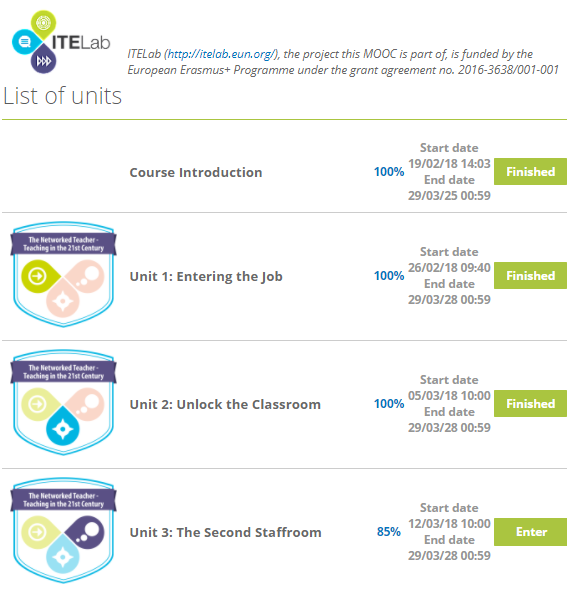
|
| |
| |
| |
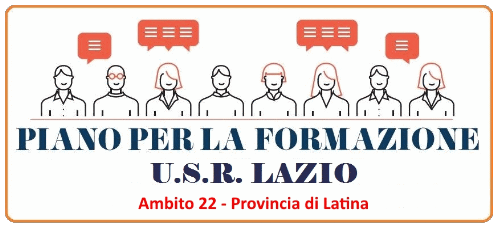
LE POTENZIALITÀ
DIDATTICHE DELLE TECNOLOGIE DIGITALI
E DEI SOCIAL MEDIA
[Home]
|
| |
| |
| |
| |
| |
| |
| |
| |
| |
| |
| |
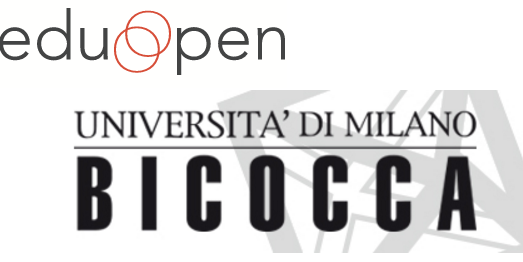
Mooc
di Teoria e tecnica dei nuovi media
https://learn.eduopen.org/
Descrizione
Questo Pathway si occupa di indagare come, in che modo e secondo
quali epistemologie, le tecnologie digitali e il Web si siano
progressivamente affermati e abbiano cambiato il mondo dell'informazione
e della comunicazione sociale così come gli stili della
comunicazione aziendale, istituzionale e giornalistica. Il
Web 2.0 e le sue applicazioni, Facebook, Twitter, Google,
Youtube, insieme a un nuova modalità di interazione
tra uomo e device – notebook tablet, e smartphone – stanno
rivoluzionando le modalità della comunicazione e del
marketing in tutto il mondo.
Il Pathway si articola in tre Mooc:
1. La
storia e gli sviluppi della rivoluzione informazionale;
2. Le
forme e i linguaggi del web;
3. La
comunicazione web e il marketing digital
|
Il MOOC
del corso nei social network
facebook
- linkedin
- twitter
- youtube
video
presentazione del corso
https://www.youtube.com/watch?v=b493vRUz1zk

Badge
emessi da Università
degli Studi di Milano-Bicocca per

https://bestr.it/project/show/49
-  LOGIN LOGIN
Badge
emesso da Bestr
Open
Badges, Life-wide Learning, Lifelong learning
[01]
- [02]
- [03]
- [04]
- [05]
[Riepilogo
attestati e bedge]
Percorso
in Teorie e Tecnica dei Nuovi Media
Descrizione: Questo Pathway si occupa di indagare come, in che
modo e secondo quali epistemologie, le tecnologie digitali e
il Web si siano progressivamente affermati e abbiano cambiato
il mondo dell'informazione e della comunicazione sociale così
come gli stili della comunicazione aziendale, istituzionale
e giornalistica. Il Web 2.0 e le sue applicazioni, Facebook,
Twitter, Google, Youtube, insieme a un nuova modalità
di interazione tra uomo e device – notebook tablet, e smartphone
– stanno rivoluzionando le modalità della comunicazione
e del marketing in tutto il mondo. Il Pathway si articola in
tre Mooc: 1. La
storia e gli sviluppi della rivoluzione informazionale;
2. Le
forme e i linguaggi del web; 3. La
comunicazione web e il marketing digitale.
|
|
| |
| |
| |
| |
| |
| |
| |
| |
| |
Emesso
da Bestr
Open
Badges, Life-wide Learning, Lifelong learning
|
| |
| 
|
| |
| |
| |
|
|
|
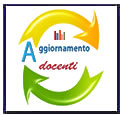
![]()
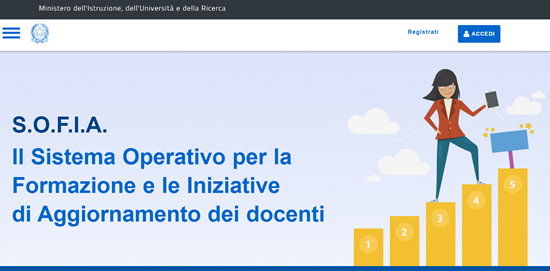





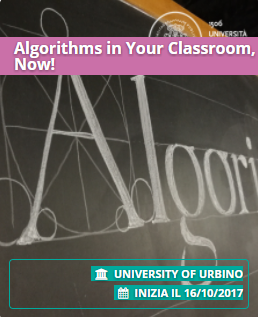
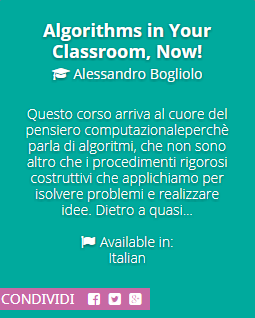
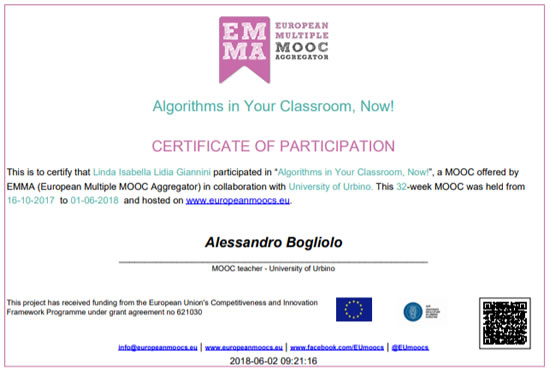
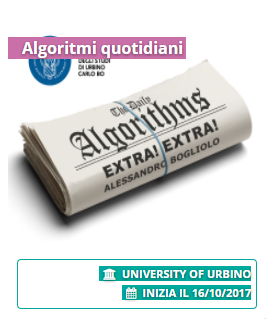
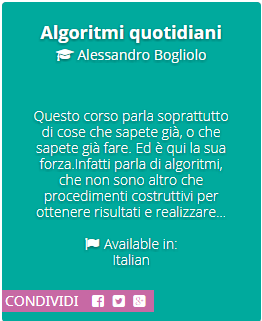
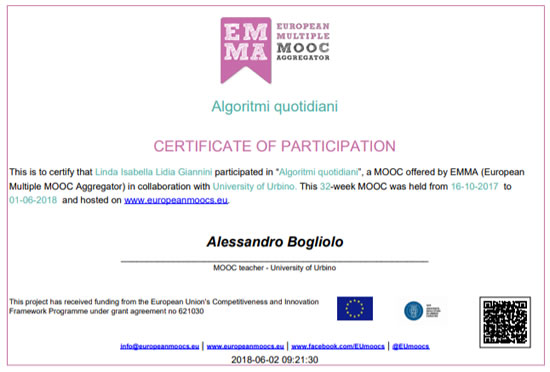
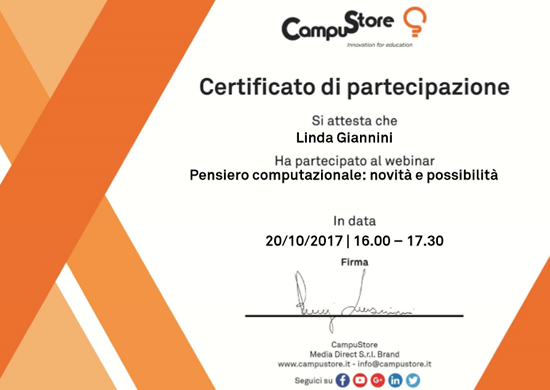



https://www.facebook.com/groups/COLABEU/
![]() https://twitter.com/hashtag/colab_eu
https://twitter.com/hashtag/colab_eu
![]()
![]() COLAB-MOOC-SYLLABUS
COLAB-MOOC-SYLLABUS![]()
![]() Collaborative
Teaching and Learning - 2nd edition
Collaborative
Teaching and Learning - 2nd edition ![]()
![]() https://www.youtube.com/watch?v=vNdIsbl2Q6Y
https://www.youtube.com/watch?v=vNdIsbl2Q6Y
![]()

![]() Login
Login
![]()

![]()



![]() Opening
Schools to STEM Careers
Opening
Schools to STEM Careers ![]()
https://www.facebook.com/groups/STEMcareersMOOC/
![]() #STEMcareersMOOC
#STEMcareersMOOC
![]()
![]() https://www.youtube.com/watch?v=o4mUYNNZpEw
https://www.youtube.com/watch?v=o4mUYNNZpEw
![]()
![]()
![]()



https://www.facebook.com/groups/spaceawarenessmoocs/
![]() #spaceMOOC
#spaceMOOC
![]()
![]() https://www.youtube.com/watch?v=FjLrBB7gXzM
https://www.youtube.com/watch?v=FjLrBB7gXzM
![]()
![]()



https://www.facebook.com/groups/progressing.technology.enhanced.teaching/
![]() https://www.youtube.com/watch?v=NkgyRijfrHk
https://www.youtube.com/watch?v=NkgyRijfrHk
![]()
![]() #MENTEPcourse
#MENTEPcourse
![]()
![]() MENTEP-EUN-Academy
MENTEP-EUN-Academy
![]()
![]() My
Competence Evidence 01
My
Competence Evidence 01 ![]()
![]() My
Competence Evidence 02
My
Competence Evidence 02
![]()



![]()



Online
Safety Facebook group
![]() Twitter
using #OnlineSafetyMOOC
Twitter
using #OnlineSafetyMOOC![]() Online
Safety - MOOC Intro
Online
Safety - MOOC Intro 
![]()


Inquiry-Based Teaching
in Life Sciences Facebook group
![]() Twitter using Inquiry-Based
Teaching in Life Sciences
Twitter using Inquiry-Based
Teaching in Life Sciences ![]() Inquiry-Based Teaching
in Life Sciences
Inquiry-Based Teaching
in Life Sciences ![]()



Inquiry-Based Teaching
in Life Sciences Facebook group
![]() Twitter using Inquiry-Based
Teaching in Life Sciences
Twitter using Inquiry-Based
Teaching in Life Sciences ![]() Inquiry-Based Teaching
in Life Sciences
Inquiry-Based Teaching
in Life Sciences ![]()

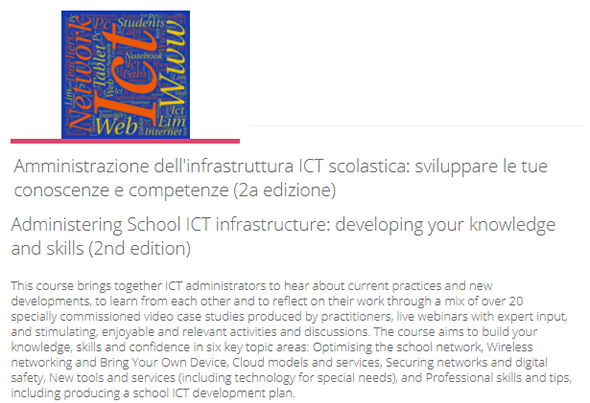
School
ICT Administrator Facebook group
![]() Twitter
using #ICTadminMOOC
Twitter
using #ICTadminMOOC![]() EUNA
- IT Administrator course rerun introduction
EUNA
- IT Administrator course rerun introduction
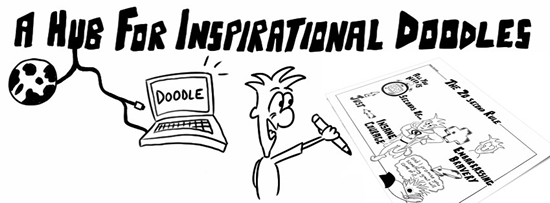
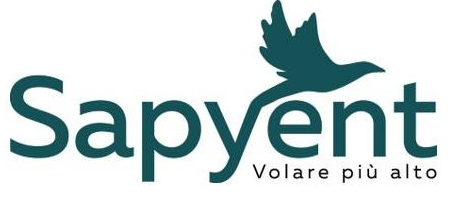
![]() https://twitter.com/hashtag/sapyent
- https://twitter.com/hashtag/sssg
https://twitter.com/hashtag/sapyent
- https://twitter.com/hashtag/sssg
![]() https://twitter.com/search?q=%23SSSG
https://twitter.com/search?q=%23SSSG https://www.facebook.com/sapyent.community/videos/293831934368441/



![]() LOGIN
LOGIN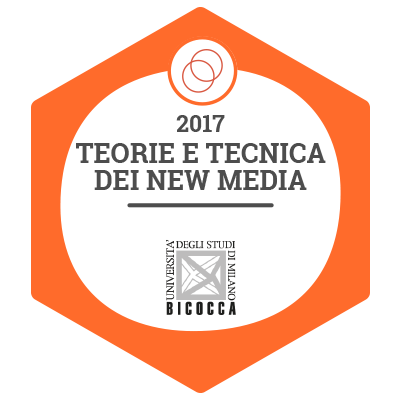
![]()
